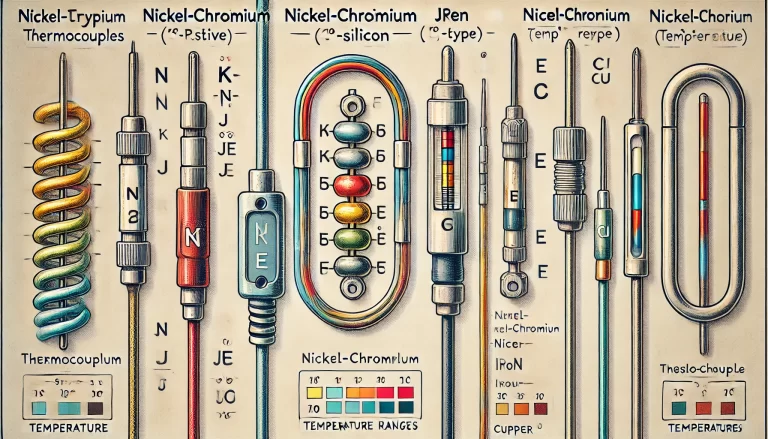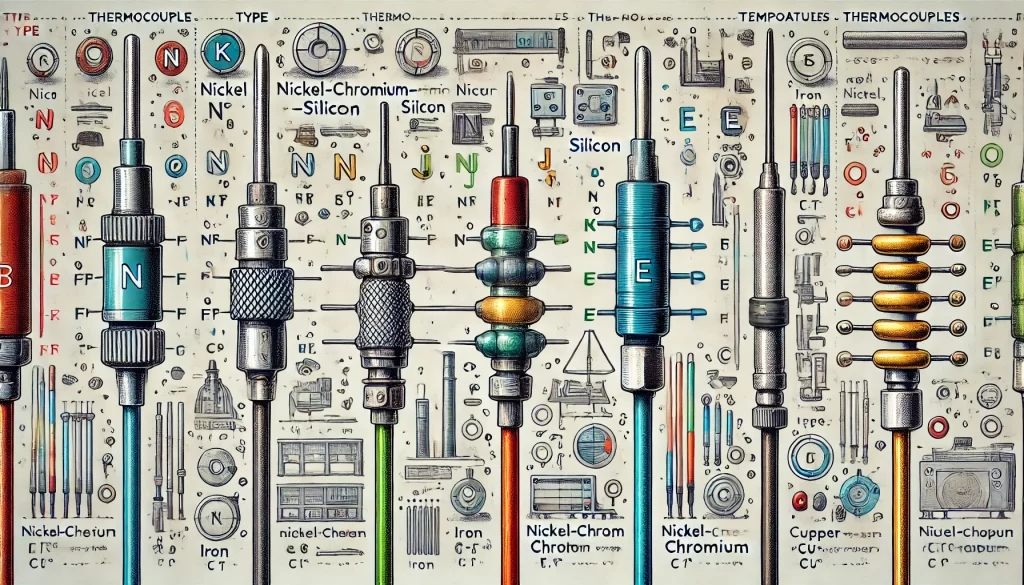Thermocouples are widely used temperature sensors that convert thermal energy into electrical energy through the Seebeck effect. They are known for their durability, wide temperature range, and ability to function in harsh environments. Among the many types of thermocouples, the K, N, J, E, and T types are the most commonly used in industrial and scientific applications. Each of these types has distinct characteristics, materials, and operating ranges that make them suitable for specific purposes. Let’s explore these thermocouple types in more detail.
1. K-Type Thermocouple
- Materials: Nickel-Chromium (NiCr) for the positive leg and Nickel-Silicon (NiSi) for the negative leg.
- Temperature Range: -200°C to 1350°C (-328°F to 2462°F).
- Key Characteristics:
- Versatility: K-type thermocouples are the most common and widely used thermocouples due to their broad temperature range and relatively low cost.
- High Oxidation Resistance: This type can withstand high temperatures and is resistant to oxidation, making it ideal for use in harsh environments.
- Accuracy: K-type thermocouples have moderate accuracy, typically within ±1.5°C, making them suitable for general industrial applications.
- Common Applications:
- K-type thermocouples are widely used in industries such as metal processing, power generation, and chemical manufacturing.
- They are also used in environments with high temperatures, such as furnaces, kilns, and turbines.

2. N-Type Thermocouple
- Materials: Nickel-Chromium-Silicon (NiCrSi) for the positive leg and Nickel-Silicon-Magnesium (NiSiMg) for the negative leg.
- Temperature Range: -200°C to 1300°C (-328°F to 2372°F).
- Key Characteristics:
- Superior Stability: N-type thermocouples are known for their exceptional stability and resistance to thermal drift at high temperatures, which makes them a preferred choice for continuous temperature monitoring in demanding conditions.
- Low Sensitivity to Oxidation: They exhibit better performance than K-type thermocouples at higher temperatures and are less prone to oxidation.
- Accuracy: They offer similar accuracy to K-type but are more stable over time, making them suitable for long-term, high-temperature applications.
- Common Applications:
- N-type thermocouples are used in industries such as glass and ceramic manufacturing, heat treatment processes, and nuclear power plants.
- Their stability and reliability make them suitable for long-term, high-temperature monitoring in these environments.
3. J-Type Thermocouple
- Materials: Iron (Fe) for the positive leg and Copper-Nickel (CuNi), commonly known as Constantan, for the negative leg.
- Temperature Range: -40°C to 750°C (-40°F to 1382°F).
- Key Characteristics:
- Moderate Temperature Range: J-type thermocouples are best suited for lower temperature ranges compared to K-type, and they are not recommended for use at temperatures exceeding 750°C due to rapid oxidation of the iron element at higher temperatures.
- Cost-Effective: J-type thermocouples are generally less expensive than K-type and are suitable for applications that do not require extremely high temperatures.
- Accuracy: J-types have a typical accuracy of ±2.2°C, making them less precise than other types, but sufficient for many general-purpose uses.
- Common Applications:
- They are commonly used in plastics manufacturing, food processing, and autoclaves.
- J-type thermocouples are particularly well-suited for applications where the environment is not highly oxidizing or where temperatures remain below 750°C.

4. E-Type Thermocouple
- Materials: Nickel-Chromium (NiCr) for the positive leg and Copper-Nickel (CuNi) for the negative leg.
- Temperature Range: -200°C to 900°C (-328°F to 1652°F).
- Key Characteristics:
- High Sensitivity: E-type thermocouples generate the highest voltage per degree of temperature change among the common thermocouple types. This makes them very sensitive to small temperature variations, especially at lower temperatures.
- Corrosion Resistance: They offer excellent corrosion resistance, particularly in moist environments.
- Accuracy: E-types are highly accurate, with typical errors in the range of ±1.7°C, and are well-suited for precision measurement.
- Common Applications:
- Due to their high sensitivity, E-type thermocouples are often used in scientific laboratories and precision instrumentation.
- They are ideal for low-temperature applications such as cryogenics, where small temperature changes need to be detected accurately.
5. T-Type Thermocouple
- Materials: Copper (Cu) for the positive leg and Copper-Nickel (CuNi) for the negative leg.
- Temperature Range: -200°C to 350°C (-328°F to 662°F).
- Key Characteristics:
- Low Temperature Precision: T-type thermocouples are highly accurate and stable at low temperatures, with an accuracy typically within ±0.5°C.
- Durability in Moist Environments: The use of copper makes them highly resistant to oxidation and corrosion, particularly in moist environments, but they are limited to lower temperatures.
- Accuracy: T-types are among the most accurate thermocouples available, making them ideal for applications that require precise temperature monitoring in cold environments.
- Common Applications:
- T-type thermocouples are frequently used in cold chain monitoring, freezer applications, and food storage.
- They are also popular in medical devices and cryogenic processes due to their high accuracy in the low-temperature range.
Comparison Table
| Thermocouple Type | Positive Leg Material | Negative Leg Material | Temperature Range | Key Applications |
|---|---|---|---|---|
| K-Type | Nickel-Chromium (NiCr) | Nickel-Silicon (NiSi) | -200°C to 1350°C | Metal processing, power generation, chemical manufacturing |
| N-Type | Nickel-Chromium-Silicon (NiCrSi) | Nickel-Silicon-Magnesium (NiSiMg) | -200°C to 1300°C | Glass, ceramic manufacturing, nuclear power |
| J-Type | Iron (Fe) | Copper-Nickel (CuNi) | -40°C to 750°C | Plastics, food processing, autoclaves |
| E-Type | Nickel-Chromium (NiCr) | Copper-Nickel (CuNi) | -200°C to 900°C | Cryogenics, precision instrumentation, scientific labs |
| T-Type | Copper (Cu) | Copper-Nickel (CuNi) | -200°C to 350°C | Cold chain, medical devices, food storage |
Conclusion
When selecting a thermocouple, it is essential to consider the application’s specific temperature range, the environment (oxidizing, reducing, or inert), the required accuracy, and the cost. K-type thermocouples are the most versatile and widely used due to their broad temperature range and cost-effectiveness. For more specialized applications, such as high-temperature stability (N-type), low-temperature precision (T-type), or high sensitivity (E-type), other types of thermocouples may be a better choice. Understanding the unique properties of each thermocouple type ensures accurate temperature measurement in various industrial, scientific, and commercial environments.
